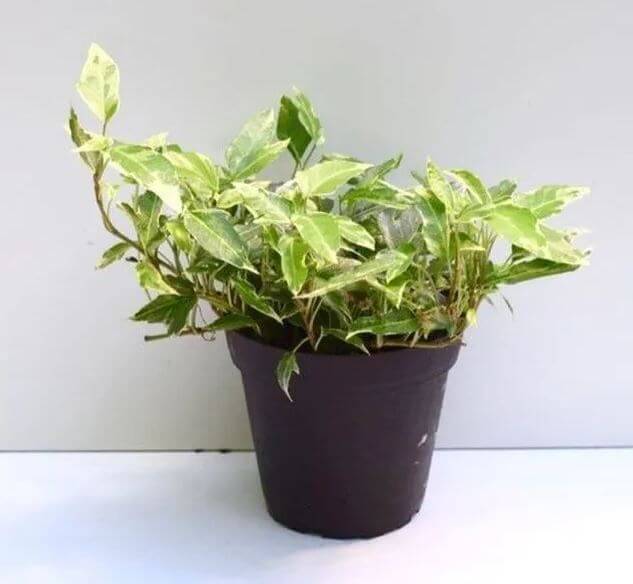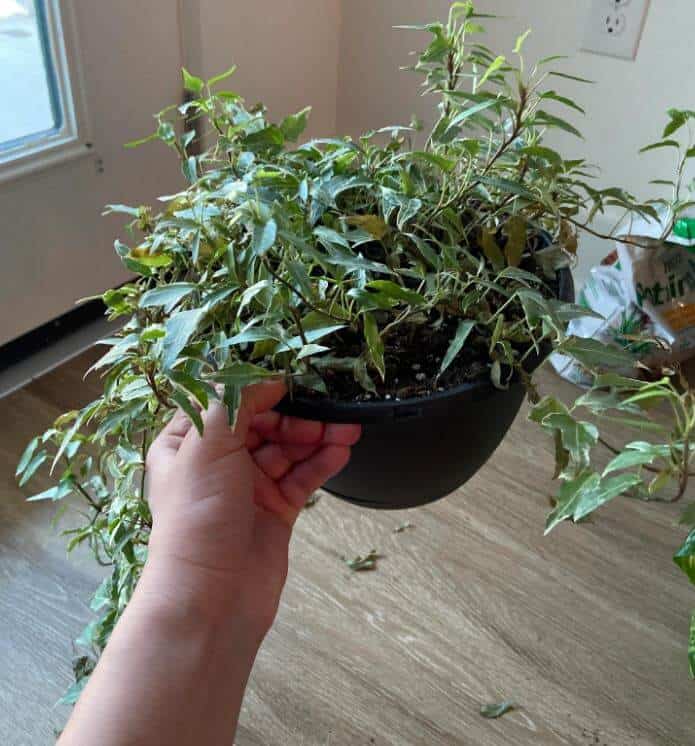Last Updated on January 6, 2023 by a Friendly Gardener
The Little Hermann Ivy plant is an evergreen vine that can grow on the ground or on vertical surfaces like walls, cliffs, and trees. It can grow 20 to 30 m high thanks to its aerial rootlets that come with matted pads, which is how the plant can cling to the substrate.
However, these plants like to grow on rough surfaces that are dark, moist, and non-reflective. They also like soil that has a near-neutral pH value which is around 6.5 under ideal circumstances.
The leaves can be anywhere from 50 to 100 mm long and each has a petiole that is 15 to 20 mm long. Some of these leaves have five lobes and creep on the stems, while some others don’t have lobes at all but still grow on fertile stems.
Now, these stems are not just fertile but also flowering which is why they grow on the crown of a tree or on top of the face of rock since those places usually receive full sunlight.
Let’s see how to care for this plant if you get one.
Little Hermann Ivy Plant Care

These plants produce flowers from the end of summer to the end of autumn. They are small and have umbel with a diameter of 1.1 to 1.9 inches. They are green-yellow in color and have a lot of nectar, which is a source of food for insects like bees.
These plants also produce fruits in the range of purple-black to orange-yellow in color. They are each 0.2 to 0.3 inches in diameter, become ripe towards the end of winter, and are a food source for many birds.
So, before you look into the Little Hermann Ivy plant care, you should know that in some places, these species are categorized as invasive species. And you now also know that they attract birds and insects.
If you’re still interested, here’s how to care for these plants.
Light

These plants grow well in moist and dark spaces. So, you want to grow them indoors in a bedroom that doesn’t get too much light. That means you can’t place it next to a window either. If you have to pick a north-facing window.
You could describe their lighting requirements as partly shady to completely shady. Since they grow so well in shade, these plants are also used as groundcover in places where grass doesn’t grow too well.
These plants grow densely and their crowd intensity must be checked from time to time. Although, they could use some direct light during the winter.
Water
These plants dry up quite quickly. And what they don’t need from the sun, they seem to take from water. So, if the top layer of soil is a little dry and the next layer is a little moist, you can go ahead and water the plant.
If you’re not sure, you should squeeze some of the soil with your fingers and see if water seeps out. If it does, you don’t have to water it. But it’s important to remember that the plant should not be waterlogged. You can’t overdo it.
It should be moist and you know what’s happening when you see it in vibrant colors.
Soil
This is an evergreen vine that needs well-drained soil. Since it has a lot of appetite for growth, it might do just fine in poor soil as long as the pH level is near neutral. The ideal kind of soil for this plant is loamy.
And you can add a little bit of mulch on top to protect it from the dry climate. Those who want to get a potting mix should pick up something that is well-drained as well as loose.
Fertilizing
These plants do okay when they get a lot of water but it’s not a bad idea to feed them some extra nutrients through a fertilizer. You could categorize their need for additional feeding to be medium.
These plants will do well if you fertilize them once a fortnight. That should be done in their growing season which is summer and spring. Get a 20-20-20 fertilizer or anything with has a 2-2-2 organic formula.
But if the plant is stressed, you shouldn’t give it any fertilizer. That means keep it off the plant when the soil is very dry, the weather is too hot or too cold, or if the plant isn’t producing any leaves.
Temperature
The ideal temperature for these plants is somewhere between 70 to 90 degrees F and the humidity is medium or high. That’s when the leaves will be dark green. They don’t respond very well to too much heat or cold winds.
Pests and Diseases
These plants tend to attract pests like mealybugs, spider mites, and aphids. But if and when that happens, you can get rid of them by spraying water or by using insecticide soap, or treating the leaves with neem oil.
You can also treat them with a mix of water and dish soap and spray the concoction on the leaves if you are only fighting an aphid attack. This is an ivy plant so you can expect leaf spotting due to bacteria as well.
This spotting turns the leaves dark brown or black. And the only way to treat them is to remove the affected leaves and spray the rest of the plant with a 10 to 1 vinegar water mix.
Root rot is also a possibility, and it is brought upon by humid or warm weather. This can be lethal to the plant and removing the affected regions is the only solution.
Pruning

You will need to prune these vines from time to time since they are such strong and dense growers. That means keeping a pair of cutting shears handy at the onset of the spring season.
Cleaning the shears is important to keep the plant free of bacterial infections. You can pinch the tips to encourage growth. If you want to get rid of the vine growing on a different plant, you can’t just rip it off.
You will have to cut the vine from its base in the soil. Otherwise, you might end up hurting the tree that the vine is growing on.
Propagation
You can propagate these plants with stem cuttings or trimmings. This can be done when you’re pruning them. You just need a stem that’s 4-5 inches long and submerge them in water. Once the roots are developed, you can shift them into the ground or a pot.
Wrapping Up

These plants are beautiful and easy to grow. But if you don’t keep an eye on them, they can get infected, and that’s a bigger problem to deal with. Caring for them is not hard. You just need to know what you’re dealing with.


